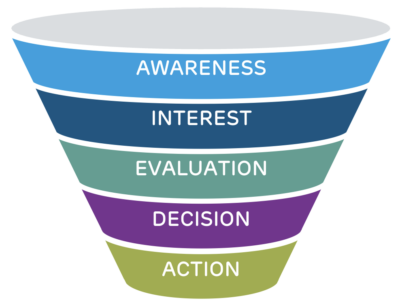Think of the sales funnel as a stage in a theater where your company plays the lead role and potential customers are the audience. They are in the crucial phase of deciding whether they are interested in your play – your product or your service. The sales funnel helps you show exactly what you have to offer. You highlight the advantages of your offers and inspire viewers so much that they become loyal customers. In this blog post you will learn how to design and use your sales funnel effectively.
But why is this knowledge so crucial? If you understand the sales funnel and use it correctly, you can identify exactly at which points potential customers hesitate or abandon the buying process. You identify what is successful and where improvements are needed. These insights allow you to develop targeted strategies to convert more prospects into actual customers. A carefully designed sales funnel leads to more effective marketing, higher customer satisfaction and increasing sales figures. It is crucial to develop the full potential of your company and to survive successfully in the market, from the initial contact to the customer deal.
Sales Funnel Definition
The sales funnel illustrates the customer process from the first contact to the purchase. Imagine the funnel: many potential customers arrive at the top, but only some go through all phases – from the first perception to the purchase.
The concept of the sales funnel emerged in the early 20th century. Back then, companies wanted to better understand and manage the purchasing process. Over time, the funnel developed further, especially through digitalization and online marketing. Today it is often a complex network of different customer paths and contact points.
Despite its evolution, the sales funnel has remained a key tool. It helps you reach potential customers and pique their interest. It also promotes the purchasing process and helps to maintain relationships.
Analysis in process and structure
The sales funnel consists of several key stages, and each one contributes significantly to the overall success of your sales process. A deep understanding of these steps will allow you to tailor your strategies and maximize conversions. Below we explain the individual sales funnel stages from 1 (awareness), 2 (interest), 3 (evaluation), 4 (decision), 5 (action) to 6 (post-purchase phase), each illustrated with examples.


1. Awareness
This is the first contact between your company and potential customers. This phase is about attracting attention and arousing interest. Here you set the course for potential customers to get to know you and your offers. You can achieve this, for example, by using targeted Google AdWords campaigns that improve your presence in relevant search queries. On social media platforms like Instagram or Facebook, you can regularly publish posts that emphasize the uniqueness of your products. Content marketing also plays an important role: by publishing blog articles that cover industry-relevant topics and show your expertise, you build trust and authority. Word of mouth, fueled by customer testimonials and recommendations from existing customers, is also an effective way to create awareness.

2. Interest
After you've captured attention, it's important to maintain and deepen interest. The goal is to get leads wanting to learn more about your products or services. This can be achieved by creating informative blog posts that highlight how your products can solve specific problems. Product presentations or how-to videos on YouTube that demonstrate how to use your products are also helpful. Additionally, webinars that delve deeper into specific topics in your industry and offering free e-books that provide valuable information and tips can further increase your target audience's interest.
3. Evaluation
Now potential customers are starting to actively consider whether they should buy. They compare offers, read reviews and look for more information. This is where detailed product information on your website, displaying authentic customer reviews and testimonials, and comparison tables that show your products compared to competitors are particularly effective.

4. Decision
In this crucial phase, leads make the purchasing decision. A clear and simple checkout process is also crucial in order not to lose customers at the last second. Limited-time discounts or special promotions, product demos or free samples can make the difference here. A clear and simple purchase process in the online shop is also important to make the purchasing process easier.

5. Action
The customer makes the purchase. But the funnel doesn’t end here either. Now it's about encouraging the customer to make the decision and ensuring a positive purchasing experience. This can be achieved through excellent customer service, fast delivery and a personal thank you note via email
6. Post-purchase phase
Long-term customer loyalty is created here. Through follow-up emails, offers on additional products, or loyalty programs, you can encourage customers to purchase again and recommend your brand. For example, by sending personalized post-purchase emails with additional information and support offers, upselling or cross-selling offers that are tailored to the previous purchase, and introducing loyalty programs with points, discounts or exclusive benefits, you promote this Repeat purchases and strengthen loyalty to your brand.
At every step of the sales funnel there is an opportunity to use the sales funnel opportunity to strengthen the customer relationship and effectively guide potential buyers through the buying process. You achieve success by recognizing and understanding each of these opportunities and tailoring your strategies accordingly.
Sales Funnel vs. Lead Nurturing
These two terms are often confused or equated. But they are fundamentally different.
1.Sales Funnel: The sales funnel is a model that depicts the entire process from the first perception of your product or service by potential customers to the completion of a purchase. It includes different phases such as awareness, interest, consideration, decision and action. The funnel helps you visualize how leads (potential customers) are moved through the process and shows where they convert into customers. It's a strategic model that helps you understand how you should align your marketing and sales efforts at each stage of the customer buying cycle.
2.Lead Nurturing: Lead nurturing refers specifically to the processes and techniques used to nurture relationships with prospects who are not yet ready to make a purchase. It is an important part of the sales funnel, especially in the early stages where interest and consideration are at the forefront. Lead nurturing includes activities such as personalized communication, providing valuable information tailored to leads' specific needs and interests, and building trust to slowly move leads toward a purchase.
In summary, the sales funnel represents the entire customer purchasing process. Lead nurturing, on the other hand, is a specific tactic within this funnel. It aims to build and maintain relationships with potential customers until they are ready to buy. Lead nurturing is therefore an integral part of an effective sales funnel.
Do you want to learn more about lead nurturing? Here you can find a blog post from us about it.
Sales Funnel vs. Sales Pipeline: Two Paths to Sales Success
Sales Pipeline, on the other hand, is a tool specifically designed for sales management. It shows where individual deals or sales opportunities are in the sales process, from the first contact to the conclusion. Each stage of the pipeline represents a step in the sales process, such as prospecting, qualification, quoting, and negotiation. Sales Pipeline enables sales teams to organize their activities, set priorities, and track the progress of sales opportunities.
Here You can find more information on the topic of sales pipeline.
The role of different tools in practice
Optimizing the sales funnel is a complex process in which every tool plays a crucial role. From the first customer approach to the final purchase, these tools help to make the funnel more efficient and effective. Below we will look at how each of these tools supports the sales funnel in practice and what advantages they can offer your company.

WordPress is a leading content management system that is ideal for creating and managing sales funnels. Using plugins like Gravity Forms or Contact Form 7, you can design effective landing pages for lead generation. With its strong content marketing capabilities and SEO tools like Yoast SEO, WordPress helps increase awareness and interest. The integration of email marketing tools enables automated communication with leads. In addition, analysis tools such as Google Analytics make it easier to monitor and optimize your funnel strategies.

HubSpot is a leading inbound marketing platform that is central to sales funnel management. It supports attracting leads through content creation, SEO and social media marketing. With features like forms and landing pages, HubSpot helps convert visitors into leads. The platform enables effective lead nurturing through email marketing and automation workflows. HubSpot analytics provide insights into funnel performance and support continuous optimization.

Salesforce is a leading CRM platform and plays an important role in designing and managing sales funnels. With extensive customer data and interaction histories, Salesforce enables detailed segmentation and personalization of customer contact. The platform offers powerful lead capture and qualification tools supported by advanced analytics. Salesforce makes it easier to automate sales processes, improve efficiency, and increase conversion rates. It also offers comprehensive analysis options to monitor and optimize funnel performance.

Zoho is a versatile CRM software. With a wide range of customer interaction and data analysis tools, Zoho enables effective management of the customer relationship through all stages of the sales funnel. From lead generation to closing the sales process, Zoho offers email marketing, automation, customer support, and sales forecasting capabilities. These tools help capture, qualify, and move leads through the funnel. Zoho's strong analytics capabilities allow it to monitor and optimize sales funnel performance, enabling continuous improvement of sales strategies. Overall, Zoho is an efficient solution for companies that want to develop a well-thought-out and well-organized sales funnel.
outlook
We have seen how essential the sales funnel is for the sales process and how various tools can optimize it in practice. In summary, a well-designed sales funnel not only increases the efficiency of your sales strategies, but also creates a deeper connection with your customers.
If you look into the future, trends are emerging that will further revolutionize the sales funnel. Artificial intelligence and machine learning are increasingly being integrated into CRM systems to better understand customer behavior and create personalized experiences. The importance of data analysis will also continue to increase in order to identify and exploit sales opportunities more precisely.
In addition, the seamless integration of various marketing and sales tools is becoming increasingly important to ensure a coherent and efficient sales funnel. This requires ongoing adaptation and innovation in the way we design and execute sales processes.
As a company, it is therefore crucial to keep up with the times and explore new technologies and approaches in order to continually improve the sales funnel. Ultimately, it's about offering your customers the best possible experience and thus ensuring your company's long-term success.
With this in mind, I wish you much success in optimizing your sales funnel and look forward to shaping the future of sales together.





